Djurgarden - Museum and Adventure Island
The museum and andventure island for young and old people

Djurgarden is the greenest island and one of the greenest cities ever. Thus, Djurgarden is very green. Some large areas are under nature conservancy, as there are some trees that are up to 600 years old and some seldom birds in this former Royal hunting garden that additionally is the only municipal park in the world that was set by the UNESCO under nature conservancy.
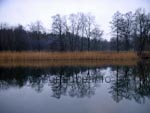
But Djurgarden has more to offer than just nature that is, among other things, the Wasa museum, the World-of-Adventure-of-Astrid-Lindgren Junibacken, the Nordic Museum, two aquaria and Skansen, the world famous open-air museum. This is why we dedicated a full day to the island, as we did not want in any case to be short of time.
Then, in the early morning, the first surprise was already waiting for us: it was not only clear but the sun was shining. Our first destination of that day was the House of Swedes (Sverigehuset) at the edge of the city centre, a big information centre for tourists. There, we wanted to buy the Stockholm-card (Stockholmskortet)that, for an equivalence of 35 euros per person, provides free entrance in nearly all museums and parks as also the free use of nearly all public transportation means for 24 hours.
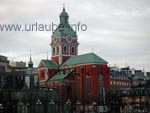
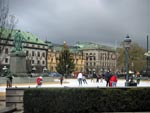
Alongside the Palace and the Opera, a footway led us into the Kungsträdgardsgatan that leads into the city district Norrmalm. Passing the red Saint Jacob's Church and an ice rink that is specially arranged for the winter time, we moved towards another Christmas market. There, we discovered a detail that is definitely missing in the German Christmas markets: firebowls. They stand around at the main footways, always loaded with some fresh wood and serve for warming the hands. A great service, whoever provides it.
Then, after a few hundred metres, we already saw at the left side the House of Swedes that offered information, cards and tickets for really all kinds of leisure time facilities. Armed with the Stockholm card, we went the same way back again, crossed the bridge to Gamla Stan and passed the front of the Palace at the Skeppsbron. From the Skeppsbron-dock, we got transferred for approximately 3,50 euro over to Djurgarden. It was indeed the only mean of transport that was not covered by the Stockholm-card, but we were previously informed about that. Therefore, the perspective from which we saw Stockholm was something very different.
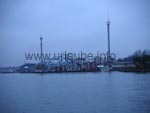
The transfer took approximately ten minutes until our boat landed right at the fun park Gröna Lund, the Tivoli of Stockholm. The illuminated fun rides as the rollercoaster and the swingboat were already visible, but from the distance they rather made a desolated impression; Well, meanwhile, the original sun cleared away long ago in order to make room for an extended grey that supplied the day with a threatening appearance of rain. Additionally, a quite cold wind blowed that insinuated that an indoor activity would be perfect for this day. And we planned such an activity with some few stations.
Thus, we rapidly went on our way after the ferry landed in an unconventional way by simply braking frontally against the quay wall in order to then continuing giving full speed away so that the passengers could get out; Any kind of planks or pedestrian facilities? Negative Report - but this does probably sound worse as it really was.
Aquaria Water Museum - From the virgin forest up to the deep sea
From now on, our Stockholm-card should be paid off. Already after some hundred metres we reached the Aquaria Water Museum and after we passed the first water gate, the room where we were got darker. Still before we knew what was going on, it started to rumble and to thunder and to rain cats and dogs, but at least our standing area was roofed. Only the silhouettes of the big tropical plants were recognizable and when it thundered, there were massive shades gliding through the water that was at our feet.
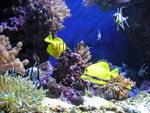
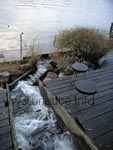
No one of the visitors that were standing with us in this tropical house said a word, as the experience, no matter how suddenly it came, had something very authentic. A rain shower at night in the jungle would probably sound similar. After the light returned, we continued over a hanging bridge to the Aquarium area.
Beside a shark pool and a coral reef with colourful sea dwellers, there is an absolute speciality to see in the Aquaria Water Museum that is the salmon leap. As the Aquaria is right located at the water, the trouts can get from the sea over a salmon leap into the interior of the museum in order to spawn there in artificial riffles. During the spawning season, this spectacle is not seldom to see. The visit of the aquarium takes approximately 30 minutes and is free with the Stockholm-card.
Wasa-Museum - a trip back to the times of the 30-year old war
The bold concrete building with the ship masts on the roof already insinuated that the interior of the building is about shipping. It forms a strong arquitectonical contrast to the Nordic Museum that is right in front of it and arranged in the style of the Renaissance which centre hall is 125 m long and 25 m wide. There, the cultural history and the population groups of Sweden of the 16th century are represented.
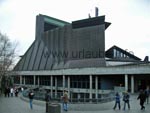
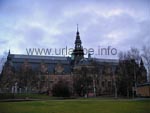
We already heard some things about the Wasa, also, that a visit of this museum should not be missed. But when we stepped into the dim-lighted main hall of the Wasa-Museum, we were more than impressed. The ship of a length of 69 m, a width of 12 m and a height of 69 m that looks exactly how one imagines a corsair, was presented to us completely restaurated.
And this after it already sank after 1000 m during the maiden trip on August 10th, 1628, and could not be recovered until 333 years later in the year 1961 from the floods of Stockholm. Some rounds on several floors around the ship made possible to us to look exactly at all carvings with which the ship is opulently adorned and also to get some deep indights into the interior of the war ship that weights 550 tons. But it was not allowed to access into the ship's interior. The construction made of more than 1000 oak trees that with its dark wood appears to be a little threatening, did not always look like that.
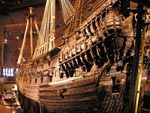
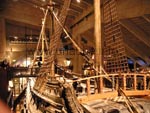
Some reconstruction boards showed that once, the Wasa must have been very colourful with some large pink parts and also the figures that adorned it must have had a colouring rather like jolly baroque putti than war artefacts, although the carvings appeared to be quite menacingly. I even think I heard the word ponce-cutter in our rows, a thing that in my opinion exactly holds true by looking closer at the reconstruction boards.
But in order still to transmit an impression of life under the deck (unfortunately, in case of the Wasa this only lasted 20 minutes), on different museum levels, some individual areas of the Wasa were copied in order to show the proportions. Moreover, there is several viewing material of the Wasa times, as for example some findings of the ship itself and also model copies and all kinds of tools, clothes and so on. A film of 15 minutes transmits some detailed information about the 17th century and the construction of the Wasa that is shown in regular periods in the in-house cinema. Also guidances are offered. In the Wasa-Museum, the entrance is free if one has a Stockholm-card.
Junibacken - with the fairy story train through the World of Adventure of Astrid-Lindgren
There are places in which either children and adults feel comfortable in a similar way. At the Entrance of Junibacken, that is only at a few hundred metres distance from the Wasa-Museum, more than 30 parked pushchairs indicated that soon it will get colourful and lively. We showed our Stockholm-card and went into a colourful world that is a coulisse of fairy tales.
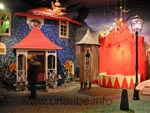
Colourful wooden houses, adorned lamps, phantasy creatures, a green artificial meadow and a wooden plane on it. In between, numerous children crowded and disappeared behind the doors or came out of them, they were laughing, scuffled and played. We smiled at what came next, as we were supposed to get on a train that moved as fast as a platen-roller during the typing. We sat two by two and were already laughing a lot when we got a safety gate fastened.
In our waggons, the german language was set, and then we could get started when our waggon finally disappeared behind the coulisses. We ignored that the audiotape voice greeted us by saying "Hello dear children" or we blamed it to the presence of the seat neighbours. What started now was a great trip through the stories of Astrid Lindgren and no matter if Pipi Langstrumpf, Michel from Lönneberga, Karlsson-on-the-Roof or Ronia, the Robber's Daughter, all of them had their performances.
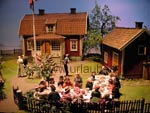
Very artfully arranged coulisses accompanied the course of the train, all of them were three dimensional copies of stages of Lindgrens books and of different sizes. Sometimes, the train moved some metres up in order to glide away over the city at the next curve, then it continued through an oversized room or alongside a huge rat, through a forest with gnomes or through a fantastic landscape. At the end of the twenty-minutes tour that provided one surprise after the other, we had to confess that we simply underestimated the attraction as we did agree that this trip was really worthwhile.
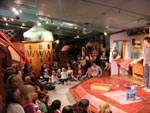
After getting out and walking some steps, we went to the stage where currently Karlsson-of-the-Roof was played. Although the actors spoke Swedish, a german child would be soon consolated from the linguistical barrier due to the way of acting combinated by the mimic and gestures. At the end we land again at a bluster room were the topic was the Villa Villeculla. From there, we continued to the Junibacken restaurant that appeared as a Mini-canteen a for little fairy tale-students. The buffet must have pleased all children, as beside köttbullar, the small meat balls and other children's dishes, there were any kind of sweeties and cake to buy. We only bought a chilled drink and left Junibacken through its huge and multilingual souvenir shop.
Skansen-Aquarium
Skansen first part: this time, not open air yet
Approximately half a kilometer distant to Junibacken, Skansen is located in the first and biggest open-air-museum of scandinavia. The Skansen-aquarium belongs to the lower part of Skansen, thus not right in the open-air museum, that is reached by a moving staircase that leads through a rock face.

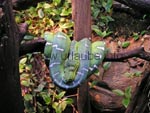
Considering its size, the Skansen-Aquarium offers a very wide spectrum of animals and, as previously the Aquaria Water Museum, set a great store by the staging and the accommodation appropriate to the species of the animals. Already in the entrance, the visitor is curiously eyeballed by some small pygmy marmosets that frolic in their spacious enclosure. There are further kinds of monkeys, but also big crocodiles, some imposing aquaria with corals, sharks and rays in which poisonous and nonpoisonous snakes and spiders live, a tropical house with giant iguanas and toucans, sloths, tortoises and parakeets and moreover, some very special events.
By this way, there is for example the part of a kitchen built behind a glass front with a double floor, opened cupboards, implements, drains and so on.
Here, it is demonstratively shown how rats can move in and underneath houses, how they creep through tubes and push themselves through the smallest holes. Also the big bawn with the small rodents that are as quick as a flash and which name I unfortunately forgot should realy please the visitors as inside there it is never boring.
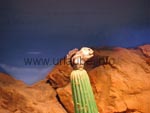
Unfortunately, it is nearly impossible to shoot a picture here as the fur bearing animals shoo in a breakneck speed through the copied desert and seldom remained sitting somwhere for more than a fraction of a second. At the end, there is the possibility for some brave adults and children to touch a small anaconda and a small tarantula under survey that are located in two glass terrariums at the exit. Although the spider made by far the most fluffy impression, it was not touched by the hands of our group members. The snake was much more successful.
As it was already evening we decided to do a side trip to Gröna Lund in order to take then the bus to the city centre. As in the winter time many attractions are closed at that time and it got anyway dark long time ago, there was also not anything else to see for us that day in Djurgarden. Also Gröna Lund was not far, it was even on our way to the bus station. Then it was in front of us and arranged after the model of the Tivolis of Copenhagen.
Gröna Lund Tivoli
Since the year 1883, a guarantor for fun, amusement and recreation
With 1,7 million visitors, Gröna Lund belongs to the top-sightseeings in Stockholm. It is the oldest and most known fun park of Sweden. Beside three rollercoasters, numerus carrousels and a catapult, Gröna Lund offers the highest free fall of Europe of 80 metres. With the Stockholm-card, the entrance is here also free.
Numerous attractions for children as the water slides and the Petterson&Findus-World as also several restaurants and coffee bars complete the offer of Gröna Lund. To the contrary, in the summer, also the open air theatre of the complex is a worthwhile destination, as there are in the evenings some vaudeville shows and open air concerts. Apart from the national artists there have also been some international top-Acts in the past as recently the Beastie Boys, Mando Diao or the metal-band Hammerfall.
In the 60ies and 70ies, there were even world stars like Janis Joplin, Paul McCartney and Louis Armstrong who stood on the stage here, while in the year 1980, Bob Marley broke the record of visitors during his third act in Gröna Lund with 27.000 visitors. After a short walk through the complex that is relatively small for a leisure park, we started our way in order to take the bus into the city centre Norrmalm.
Back to the index Stockholm

Author: Ingo Schmidt; Copyright: Patrick Wagner, www.tourist-guide.biz
|